Power Enhancement and Spot Homogenization Design for Arrayed Semiconductor Lasers
Abstract
:1. Introduction
- A rotationally polarized optical model that balances high optical coupling efficiency and high spot uniformity is designed to improve the comprehensive performance of arrayed semiconductor lasers;
- The spot uniformity parameter is introduced, and the new optical model of the array laser is compared to the traditional model. The results show that its spot uniformity was improved by 24.03%, and the optical coupling efficiency reached 89.04%;
- The relationship between the positional deviation of key optical components and the coupling efficiency in the novel optical model was analyzed, which provides reliable theoretical guidance for the subsequent packaging of fiber lasers.
2. Theory Analysis and Optical Path Design
2.1. Beam Shaping and Quality
2.2. Optical Model Design and Analysis
3. Coupling Tolerance Analysis and Discussion
4. Conclusions
Author Contributions
Funding
Data Availability Statement
Conflicts of Interest
References
- Wu, Y.; Dong, Z.; Chen, Y.; Qi, Y.; Yuan, X.; Qi, Y.; Xu, L.; Lin, X.; Zou, Y.; Zhao, P. Beam shaping for kilowatt fiber-coupled diode lasers by using one-step beam cutting-rotating of prisms. Appl. Opt. 2016, 55, 9769–9773. [Google Scholar] [CrossRef]
- Maina, A.; Coriasso, C.; Codato, S.; Paoletti, R. Degree of Polarization of High-Power Laser Diodes: Modeling and Statistical Experimental Investigation. Appl. Sci. 2022, 12, 3253. [Google Scholar] [CrossRef]
- Poprawe, R. High power diode lasers: Technology and applications. Proc. SPIE 2007, 3888, 162–174. [Google Scholar]
- Injeyan, H.; Goodno, G.D. High-power diode laser arrays. In High-Power Laser Handbook; McGraw-Hill: New York, NY, USA, 2011; pp. 133–159. [Google Scholar]
- Jing, H.; Zhong, L.; Ni, Y.; Zhang, J.; Liu, S.; Ma, X. Design and simulation of a novel high-efficiency cooling heat-sink structure using fluid-thermodynamics. J. Semicond. 2015, 36, 122006. [Google Scholar] [CrossRef]
- Zhou, Z.P.; Bo, B.X.; Gao, X.; Wang, W.; Xu, L.Y.; Wang, Y.H.; Zhou, L. Fiber coupling design of high power semiconductor laser based on ZEMAX. Chin. J. Lumin. 2013, 34, 1208–1212. (In Chinese) [Google Scholar] [CrossRef]
- Gokce, M.C.; Baykal, Y.; Ata, Y. Fiber-Coupling Efficiency of Laser Array Beam from Turbulent Atmosphere to Fiber Link. J. Light. Technol. 2023, 41, 59–65. [Google Scholar] [CrossRef]
- Hu, M.; Zhang, W.; Cao, P.; Li, T.; Zhou, X.; Zheng, W. Spectral Beam Combining with Beam Shaping of Distributed 2D Multi-Single Emitters Laser Diode Array. IEEE Photonics Technol. Lett. 2024, 36, 693–696. [Google Scholar] [CrossRef]
- Ma, Z.; Sun, X.; Zhong, S.; Duan, L.; Zhang, F.; Duan, J.-A. Coupling multi-beam laser diode to multimode fiber by wedge prism combiner. Opt. Fiber Technol. 2024, 84, 103723. [Google Scholar] [CrossRef]
- Ghasemi, S.H.; Lafouti, M. A beam shaping design for coupling high power diode laser stack to fiber with capability of spectral narrowing and stabilizing. Opt. Commun. 2012, 285, 2879–2882. [Google Scholar] [CrossRef]
- Yu, J.; Guo, L.; Wu, H.; Wang, Z.; Tan, H.; Gao, S.; Wu, D.; Zhang, K. Beam shaping design for compact and high-brightness fiber-coupled laser-diode system. Appl. Opt. 2015, 54, 5759–5763. [Google Scholar] [CrossRef]
- Xiong, L.L.; Cai, L.; Zheng, Y.F.; Liu, H.; Zhang, P.; Nie, Z.Q.; Liu, X.S. Slow axis collimation lens with variable curvature radius for semiconductor laser bars. Opt. Laser Technol. 2016, 77, 1–5. [Google Scholar] [CrossRef]
- Yan, Y.X.; Zheng, Y.; Duan, J.A. Influence of positioning errors of optical shaping components for single emitter laser diode on beam shaping effects. J. Cent. South Univ. 2019, 26, 2814–2821. [Google Scholar] [CrossRef]
- Yu, H.; Ma, X.; Zou, Y.; Jin, L.; Xu, Y.; Xu, L.; Zhang, H. Beam shaping design for fiber-coupled laser-diode system based on a building block trapezoid prism. Opt. Laser Technol. 2019, 109, 366–369. [Google Scholar] [CrossRef]
- Lou, B.; Ding, B.; Zhao, P.; Miao, Z.; Yu, H.; Lin, X. A 27-W continuous-wave fiber-coupled green diode laser based on TO-can-packaged emitters. Optik 2021, 227, 166040. [Google Scholar] [CrossRef]
- Gangopadhyay, S.; Sarkar, S.N. Laser diode to single-mode fibre excitation via hyperbolic lens on the fibre tip: Formulation of ABCD matrix and efficiency computation. Opt. Commun. 1996, 132, 55–60. [Google Scholar] [CrossRef]
- Huang, Z.; Guo, J.; Fu, Y. Various methods to evaluate laser beam quality. Laser J. 2004, 3, 1–3. [Google Scholar]
- Hu, J.-Y.; Lin, C.-P.; Hung, S.-Y.; Yang, H.; Chao, C.-K. Semi-ellipsoid microlens simulation and fabrication for enhancing optical fiber coupling efficiency. Sens. Actuators 2018, 147, 93–98. [Google Scholar] [CrossRef]
- Kanskar, M.; Bai, C.; Bao, L.; Chen, Z.; Chiong, C.; DeFranza, M.; Fortier, K.; Hemenway, M.; Li, S.; Martin, E.; et al. High brightness diodes and 600W 62% efficient low SWaP fiber-coupled package. In Proceedings of the High-Power Diode Laser Technology XVIII, San Francisco, CA, USA, 2–4 February 2020; SPIE: Bellingham, WA, USA, 2020; Volume 11262, pp. 70–75. [Google Scholar]
- Ghasemi, S.H.; Hantehzadeh, M.R.; Vatani, V.; Karimi, M.; Hejaz, K.; Kazemi, S.; Lafouti, M.; Sabbaghzadeh, J. High Brightness Fiber-Coupling Technique for High Power Diode Laser Bars. In Proceedings of the 2011 Symposium on Photonics and Optoelectronics (SOPO), Wuhan, China, 16–18 May 2011; pp. 1–3. [Google Scholar]
- Peng, G.; Ye, R.; Chang, S.; Yang, J.; Yang, J. Effect of incidence angle on optical properties of MacNeille polarizing beam splitter. In Proceedings of the Lasers & Electro Optics & The Pacific Rim Conference on Lasers and Electro-Optics, Shanghai, China, 30 August–3 September 2009. [Google Scholar]
- Zhao, Y.B.; Fang, F.Z. Beam splitter effect in Hartmann-Shack ocular wavefront sensing. Opt. Laser Eng. 2024, 175, 108020. [Google Scholar] [CrossRef]
- Shi, L.D.; Lu, L.D.; Chen, W.Q.; Chen, G.; He, Y.L.; Ren, G.H.; Zhu, L.Q. Si-Based Polarizer and 1-Bit Phase-Controlled Non-Polarizing Beam Splitter-Based Integrated Metasurface for Extended Shortwave Infrared. Nanomaterials 2023, 18, 2592. [Google Scholar] [CrossRef]
- Mastriani, M. Explaining the results of quantum mechanics via entanglement closed loop. Opt. Quantum Electron. 2024, 5, 801. [Google Scholar] [CrossRef]
- Meng, X.D.; Wan, C.H.; Zhan, Q.W. Transversely oriented cylindrically polarized optical fields. Opt. Express 2022, 30, 14897–14909. [Google Scholar] [CrossRef]
- Li, D.H.; Xuan, Y.M. Concept design and simulation of a concentration lens with uniform square irradiance. Opt. Commun. 2017, 400, 9–19. [Google Scholar] [CrossRef]
- Jiang, X.J.; Li, J.H. An evaluation of target irradiation uniformity based on spatial-spectrum analysis. Optik 2012, 123, 1411–1414. [Google Scholar] [CrossRef]

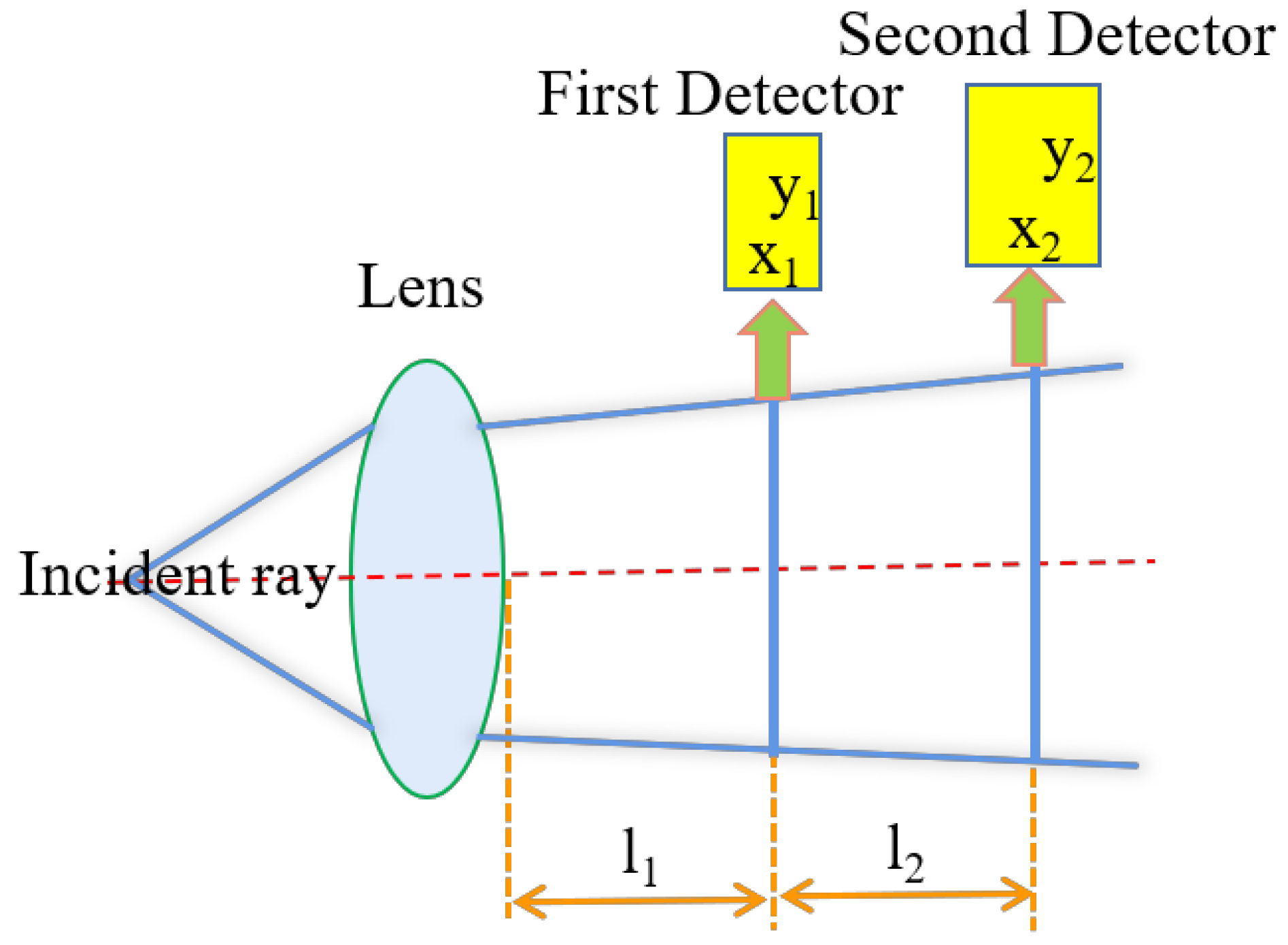
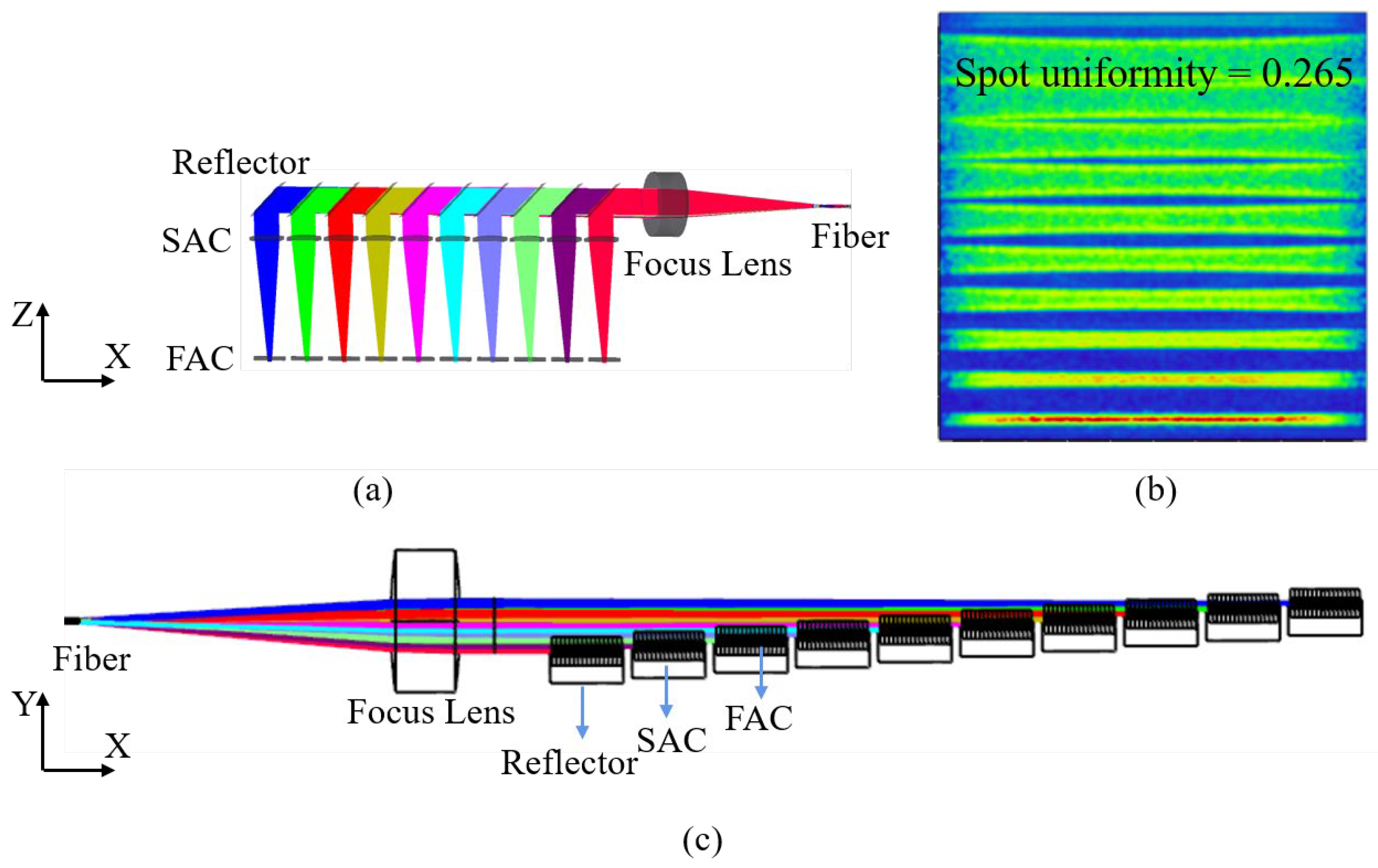
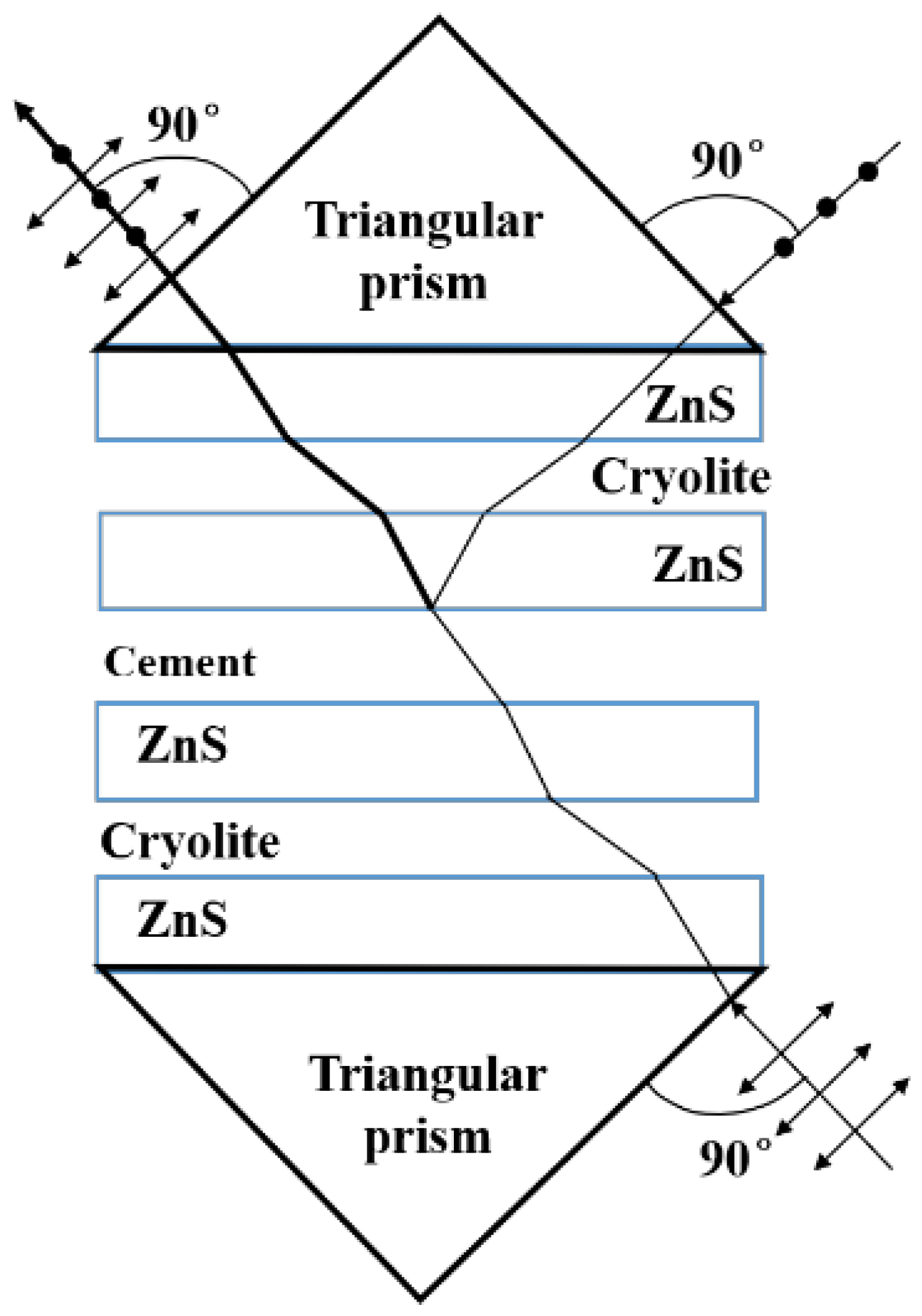
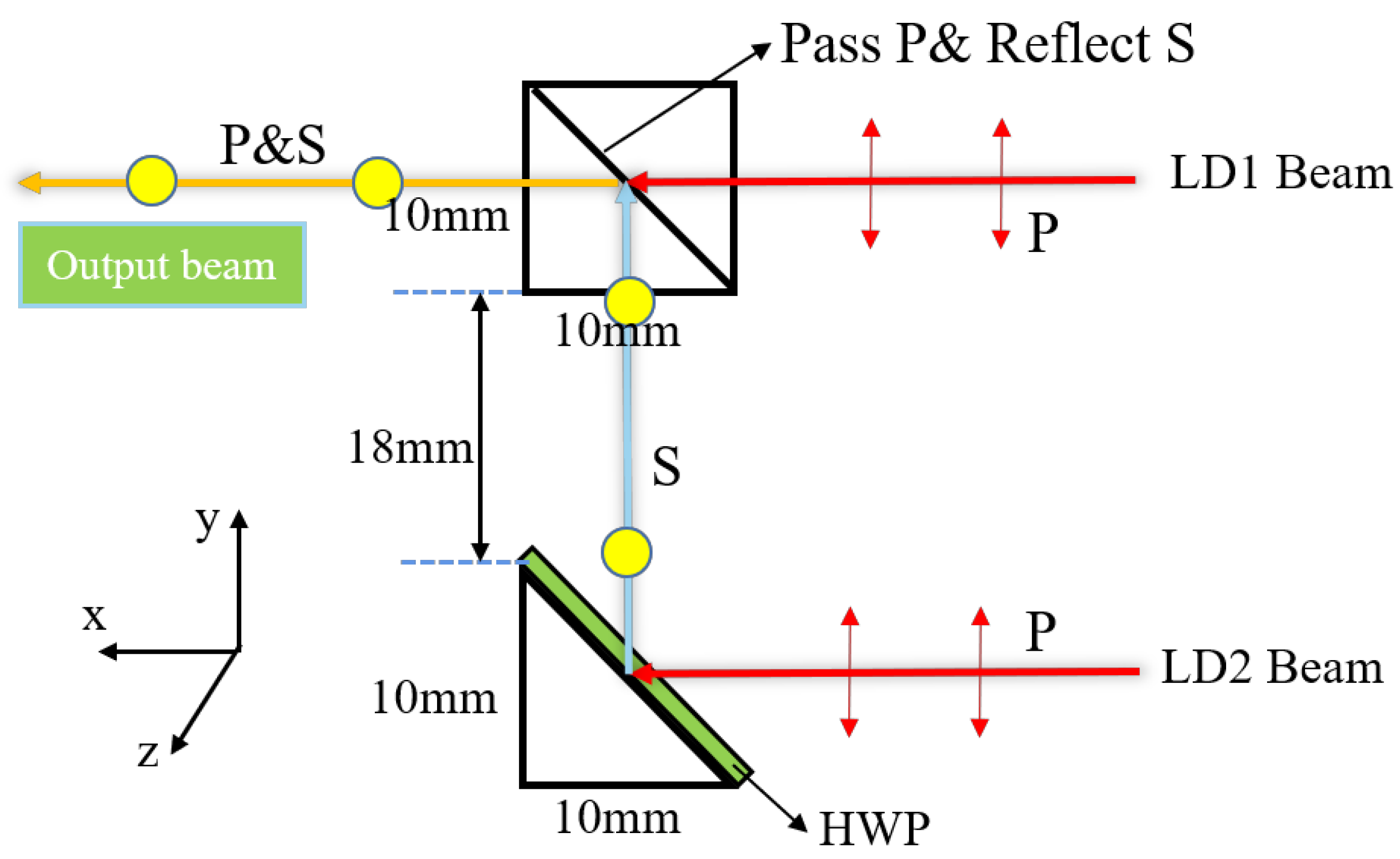


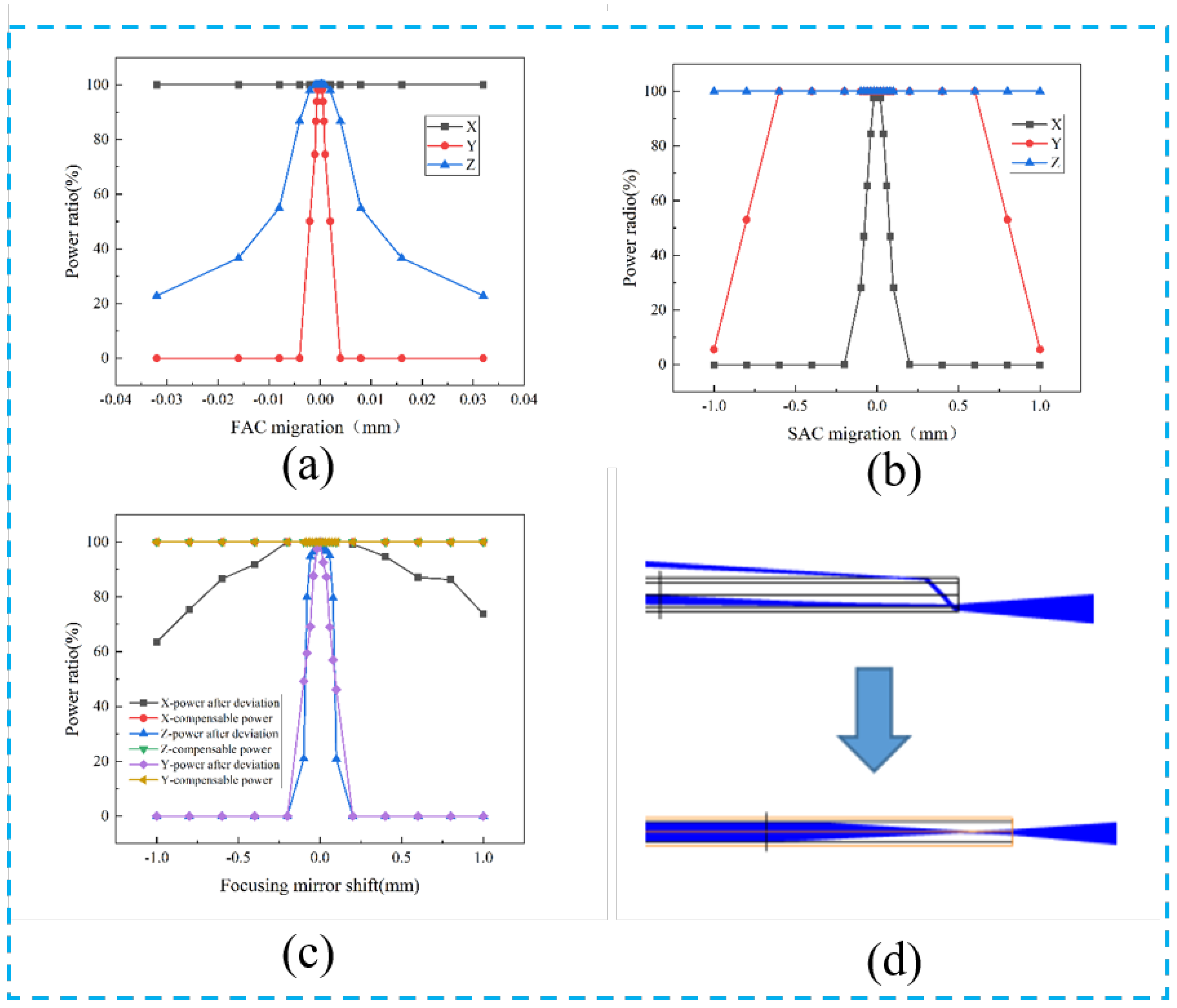
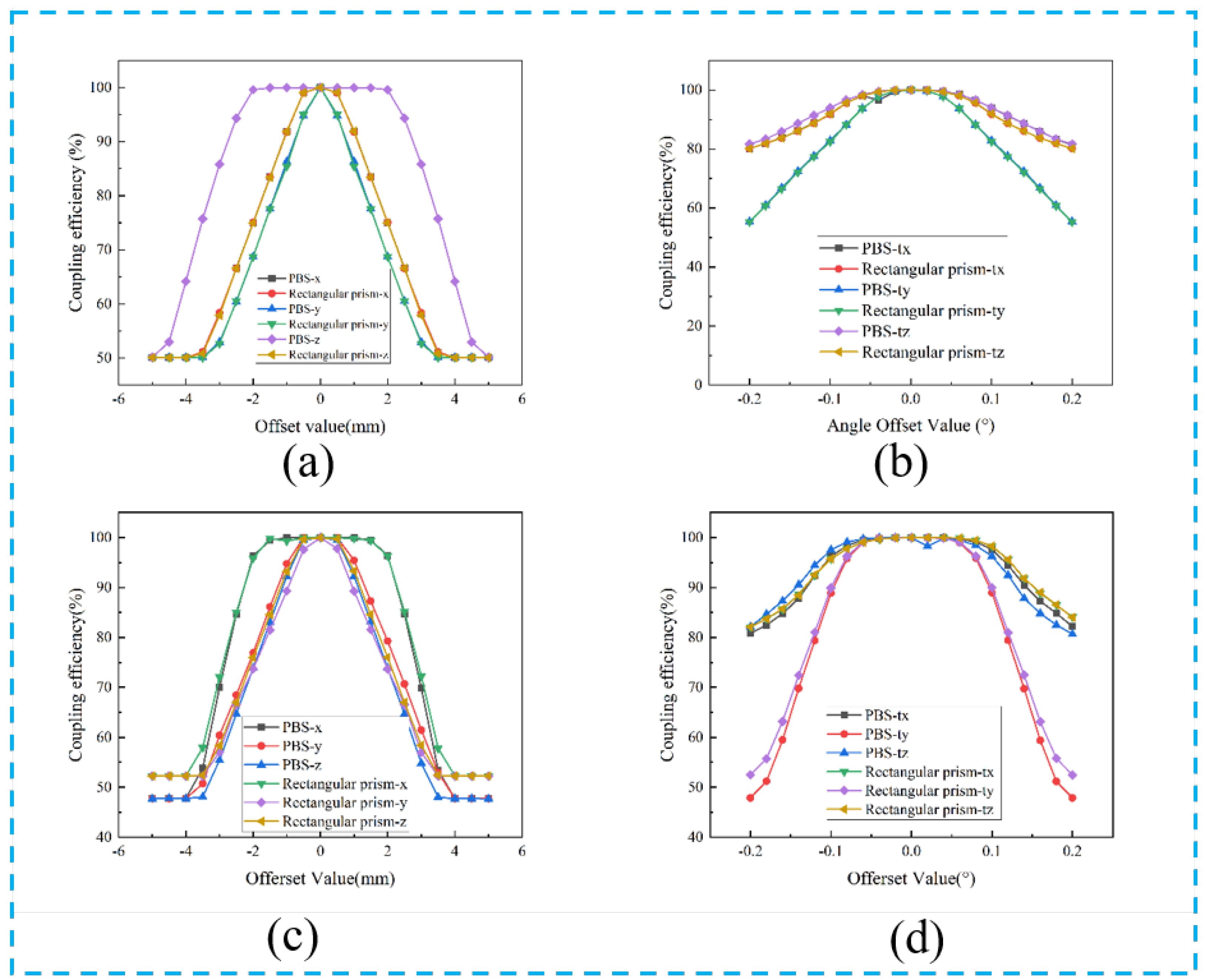
| (mm) | (mrad) | BPP (mm·mrad) | |
|---|---|---|---|
| Fast axis | 0.305 | 1.94 | 0.592 |
| Slow axis | 1.655 | 4.98 | 8.242 |
| Optical Elements | Reflectance/Transmittance | Size (mm) |
|---|---|---|
| FAC | 0.2% | 0.3 × 4 × 0.53 |
| SAC | 0.2% | 2 × 0.8 × 0.6 |
| Reflector | 99.5% | 3 × 1 × 0.2 |
| HWP | 0.2% | \ |
| Rectangular prism | 99.8% | 2 × 2 × 2 |
| PBS | P-polarized −90%, S-polarized −99.5% | \ |
| Focusing mirror | 0.5% | 4 (Diameter) × 4 |
| Model | Non-Polarized Model | Polarization Combined Beam Path Model | Rotationally Polarized Combined Beam Path Model |
|---|---|---|---|
| Number of light sources | 10 | 20 | 20 |
| Spot uniformity | 0.265 | 0.412 | 0.511 |
| Power before focusing mirror (W) | 95.53 | 183.44 | 184.94 |
| Total power (in fiber) | 91.06 | 177.22 | 178.08 |
Disclaimer/Publisher’s Note: The statements, opinions and data contained in all publications are solely those of the individual author(s) and contributor(s) and not of MDPI and/or the editor(s). MDPI and/or the editor(s) disclaim responsibility for any injury to people or property resulting from any ideas, methods, instructions or products referred to in the content. |
© 2024 by the authors. Licensee MDPI, Basel, Switzerland. This article is an open access article distributed under the terms and conditions of the Creative Commons Attribution (CC BY) license (https://creativecommons.org/licenses/by/4.0/).
Share and Cite
Zhong, S.; Xiong, J.; Xu, C.; Zhang, F.; Duan, J. Power Enhancement and Spot Homogenization Design for Arrayed Semiconductor Lasers. Micromachines 2024, 15, 744. https://doi.org/10.3390/mi15060744
Zhong S, Xiong J, Xu C, Zhang F, Duan J. Power Enhancement and Spot Homogenization Design for Arrayed Semiconductor Lasers. Micromachines. 2024; 15(6):744. https://doi.org/10.3390/mi15060744
Chicago/Turabian StyleZhong, Shunshun, Jun Xiong, Cong Xu, Fan Zhang, and Ji’an Duan. 2024. "Power Enhancement and Spot Homogenization Design for Arrayed Semiconductor Lasers" Micromachines 15, no. 6: 744. https://doi.org/10.3390/mi15060744





